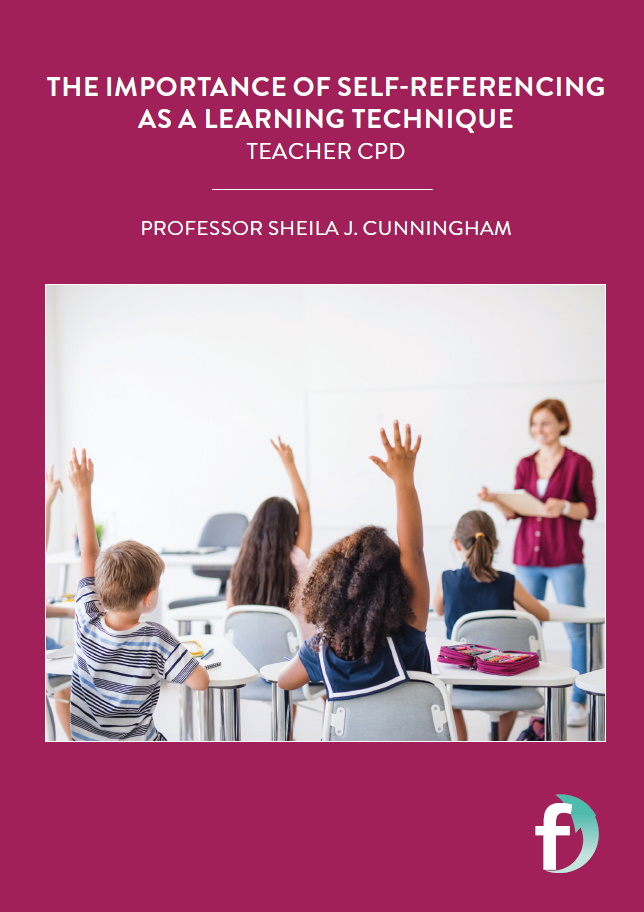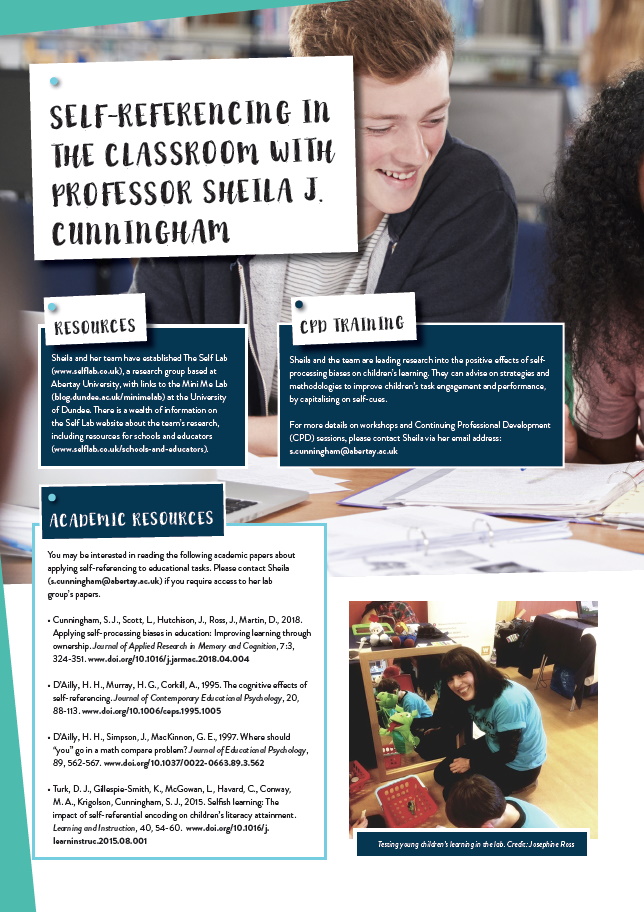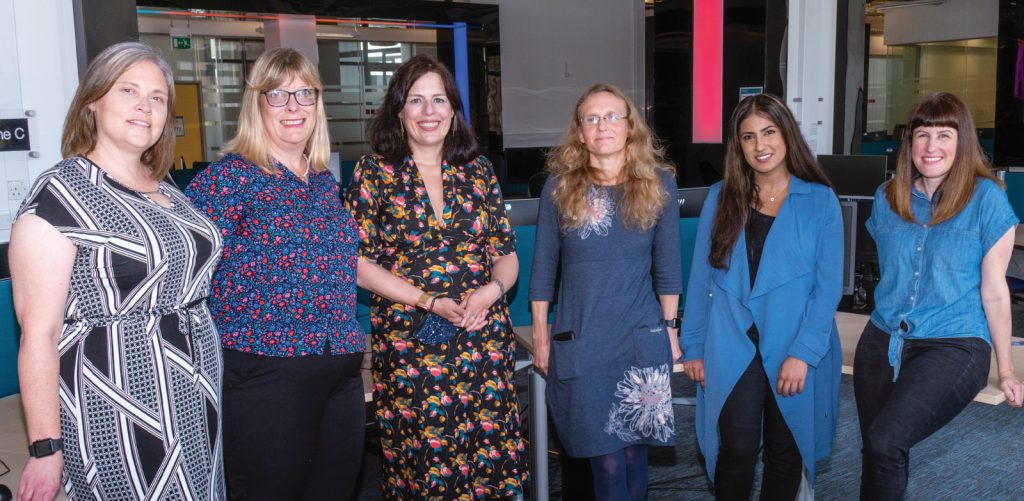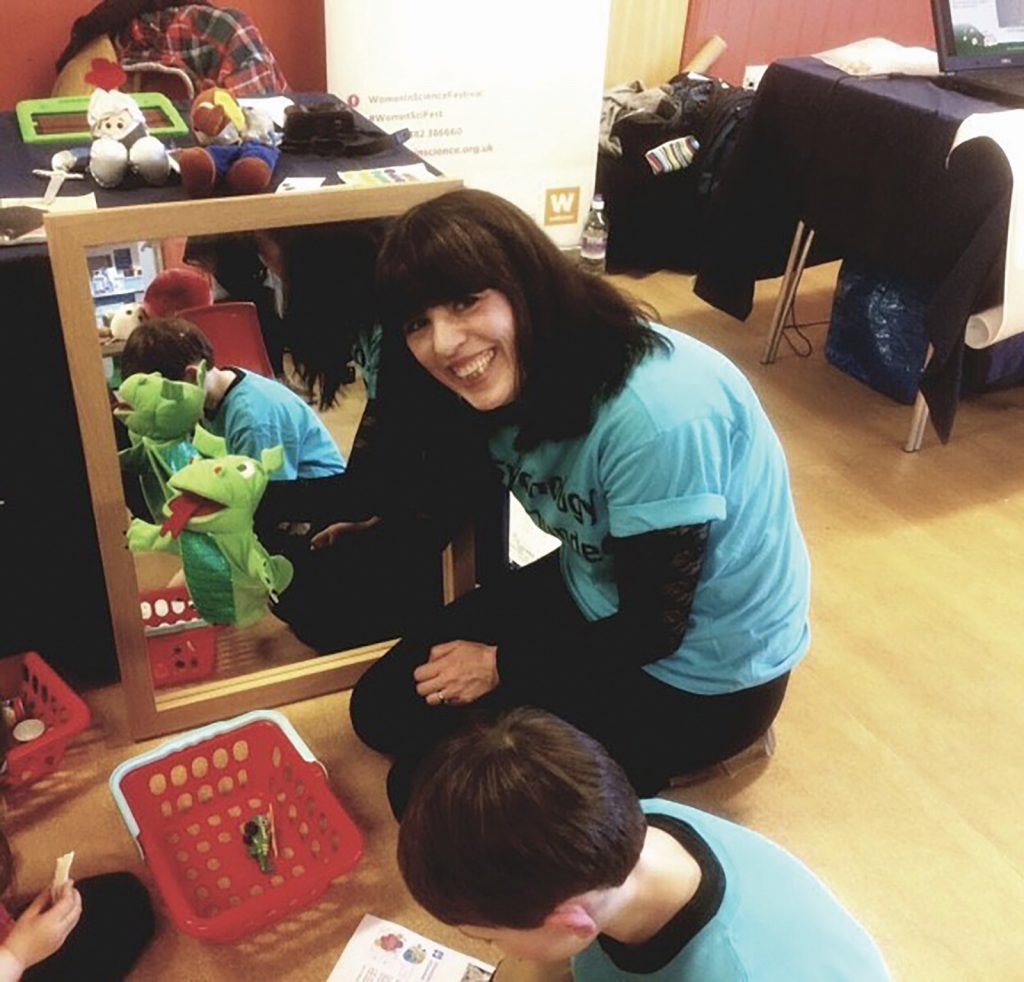The importance of self-referencing as a learning technique
How can you increase the engagement of your class? How can you improve your students’ ability to remember what you teach them? Professor Sheila J. Cunningham, a psychologist at Abertay University in the UK, is leading a team investigating the role that self-referencing can play in enhancing memory and increasing classroom engagement
How is it that we remember something? And why do we remember some things better than others? Memory plays a hugely important role in our learning. Learning can be defined as acquiring knowledge or new skills, but we also need to maintain access to this new information, so that we can retrieve and apply what we have learned in the future. For this reason, memory is pivotal to learning.
Rhymes and mnemonics are common tools for helping us to remember information. During maths classes, do your students hum along to the to the tune of ‘Pop! Goes the weasel’?
Half the sum of the parallel sides,
Times the differences between them,
That’s the way you calculate,
The area of a trapezium!
Or do they remember the order of the planets from the sun using My Very Easy Method Just Speeds Up Naming Planets – Mercury, Venus, Earth, Mars, Jupiter, Saturn, Uranus, Neptune (prior to the banishment of Pluto)?
Adding to these well-known methods of supporting memory, Professor Sheila J. Cunningham of Abertay University, a psychologist specialising in social cognition, is investigating a method known as ‘self-referencing’. Sheila is leading an ESRC-funded project exploring how self-referencing can have a positive impact on memory and learning, with colleagues Dr Janet Mclean (Abertay University) and Dr Josephine Ross (University of Dundee), and research staff Dr Joshua March and Karen Golden. The project is based on findings that self-referencing, self-knowledge and self-cues can easily be applied in the classroom, providing simple ways of increasing student engagement and knowledge retention.
WHAT ARE SELF-REFERENCING, SELF-KNOWLEDGE AND SELF-CUES?
“Self-referencing is simply the process of linking information with yourself,” says Sheila. This is a useful tool for improving memory, because if you process information while associating it with yourself, you are more likely to remember the information than if you process it in relation to someone else.
“Self-knowledge is the term used to describe the network of information about ourselves that we hold in our memory,” says Sheila. This includes knowledge about our character traits, facts about ourselves and the autobiographical memories we hold. “And self-cues are things we encounter that link to our self-knowledge.” This could be our own name, an image of our own face or belongings, or even words like our pet’s name. When we perceive a self-cue, that activates our self-knowledge and attracts our attention.
HOW DO SELF-KNOWLEDGE AND SELF-CUES IMPACT ON MEMORY?
Both self-knowledge and self-cues have a strengthening effect on our memory. “There is over forty years of research showing that when self-cues are encountered or self-knowledge is activated, a strong memory trace is produced,” explains Sheila. “This research consistently shows that if participants are asked to think about a list of trait words (e.g., kind, tidy, calm) in relation to themselves (“Does this word describe you?”), in relation to another person (“Does this word describe Beyoncé?”), or in a non-social way (“Is this a positive word?”), words considered in relation to the self are remembered better. This is known as the ‘self-reference effect’ on memory.”
Sheila and her team have built on these early findings, showing that to produce a self-reference effect on memory, it is not even necessary to evaluate the trait words. “Our research shows that simply presenting the word alongside the participant’s own name or face onscreen results in better memory for that word,” explains Sheila. Studies like these show that self-knowledge and self-cues produce a robust memory advantage.
Reference
https://doi.org/10.33424/FUTURUM181
Rhymes and mnemonics are common tools for helping us to remember information. During maths classes, do your students hum along to the to the tune of ‘Pop! Goes the weasel’?
Half the sum of the parallel sides,
Times the differences between them,
That’s the way you calculate,
The area of a trapezium!
Or do they remember the order of the planets from the sun using My Very Easy Method Just Speeds Up Naming Planets – Mercury, Venus, Earth, Mars, Jupiter, Saturn, Uranus, Neptune (prior to the banishment of Pluto)?
Adding to these well-known methods of supporting memory, Professor Sheila J. Cunningham of Abertay University, a psychologist specialising in social cognition, is investigating a method known as ‘self-referencing’. Sheila is leading an ESRC-funded project exploring how self-referencing can have a positive impact on memory and learning, with colleagues Dr Janet Mclean (Abertay University) and Dr Josephine Ross (University of Dundee), and research staff Dr Joshua March and Karen Golden. The project is based on findings that self-referencing, self-knowledge and self-cues can easily be applied in the classroom, providing simple ways of increasing student engagement and knowledge retention.
WHAT ARE SELF-REFERENCING, SELF-KNOWLEDGE AND SELF-CUES?
“Self-referencing is simply the process of linking information with yourself,” says Sheila. This is a useful tool for improving memory, because if you process information while associating it with yourself, you are more likely to remember the information than if you process it in relation to someone else.
“Self-knowledge is the term used to describe the network of information about ourselves that we hold in our memory,” says Sheila. This includes knowledge about our character traits, facts about ourselves and the autobiographical memories we hold. “And self-cues are things we encounter that link to our self-knowledge.” This could be our own name, an image of our own face or belongings, or even words like our pet’s name. When we perceive a self-cue, that activates our self-knowledge and attracts our attention.
HOW DO SELF-KNOWLEDGE AND SELF-CUES IMPACT ON MEMORY?
Both self-knowledge and self-cues have a strengthening effect on our memory. “There is over forty years of research showing that when self-cues are encountered or self-knowledge is activated, a strong memory trace is produced,” explains Sheila. “This research consistently shows that if participants are asked to think about a list of trait words (e.g., kind, tidy, calm) in relation to themselves (“Does this word describe you?”), in relation to another person (“Does this word describe Beyoncé?”), or in a non-social way (“Is this a positive word?”), words considered in relation to the self are remembered better. This is known as the ‘self-reference effect’ on memory.”
Sheila and her team have built on these early findings, showing that to produce a self-reference effect on memory, it is not even necessary to evaluate the trait words. “Our research shows that simply presenting the word alongside the participant’s own name or face onscreen results in better memory for that word,” explains Sheila. Studies like these show that self-knowledge and self-cues produce a robust memory advantage.
WHY DO WE REMEMBER INFORMATION BETTER IF IT RELATES TO US?
Put simply, the more relevant a cue is to you, the more it will attract your attention. Think about when you overhear someone using your name in conversation – your ears are instantly pricked. From a psychological point of view, this system ensures we keep track of information that is potentially important to us, thereby increasing the likelihood that a reliable memory trace for that information will be encoded and stored.
Once encoded, self-referenced memories can be linked to existing self-knowledge. Our long-term memory is organised categorically, with all the information linked to a central construct stored as a network. When one part of that network is activated, it increases the activation of the other associated memory (e.g., when the word ‘doctor’ is activated, associated constructs like ‘nurse’, ‘medicine’ and ‘hospital’ would also increase in activation). “Because we have such a vast and frequently accessed store of self-knowledge, this category is particularly rich and easily accessed,” says Sheila. “This means that incoming information that is related to us has an accessible framework to slot into, linking it to other self-related information.”
HOW CAN SELF-REFERENCING BE USED IN THE CLASSROOM TO HELP LEARNING, AND HOW DOES IT DIFFER FROM PERSONALISATION?
Personalisation is a reasonably well-established teaching method, where engagement is encouraged by making teaching materials relevant to the interests of children. Maths problems may be based around popular hobbies like football, or students may be asked to write about a well-known celebrity. While this is a great encouragement tool, not every child has the same interests. This means that materials used in the classroom can only be ‘personalised’ around generic themes. To create truly personalised materials would necessitate individual resources tailored for each child, requiring additional time and money to provide these.
“The good thing about using self-referencing is that we know every child is interested in themselves!” says Sheila. This means that simple self-referencing techniques can result in generic teaching materials that are nevertheless personal to each child, encouraging every student to engage. “Simply adding the pronoun ‘you’ creates a self-referent version of a task, problem or worksheet,” Sheila explains.
WHAT HAS SHEILA OBSERVED WHEN SELF-REFERENCING IS USED IN THE CLASSROOM?
Sheila and her team are working with teacher focus groups from Scottish primary schools to develop their understanding of how self-referencing can be applied within common educational practices. They have been testing children’s performances on classroom tasks to examine the impact of self-referencing on different types of attention and memory. So far, their work has focused on exploring the use of personal pronouns to activate self-referencing in numeracy (problem solving) and literacy (close reading) tasks.
“There is evidence that including personal pronouns in maths problem solving tasks can improve the speed and accuracy of responses,” says Sheila. “For example, in word problems with multiple characters (Sally has three balls and Johnny has four balls. How many balls are there altogether?), speed and accuracy are improved by replacing one of the characters with the pronoun ‘you’ (You have three balls and Johnny has four balls. How many balls are there altogether?).” Children engage more with the activity when they are included within the task itself and by altering the task to include the pronoun ‘you’, it becomes self-referent.
In other research Sheila has been involved with, it was observed that children wrote longer and more accurate sentences if they began the sentence with the word ‘I’. One week, children were asked to write self-referent sentences, starting each with the word ‘I’. The next week, they were asked to write sentences about Harry Potter, beginning every sentence with ‘Harry’. “The children wrote sentences that were around 10% longer in the self-referent week, suggesting they were more engaged in the task,” says Sheila. “And when later tested on the spelling of the words used in their sentences, we found significantly better performance of words from the self-referent sentences. Words from the self-referent sentences produced test scores around 13% higher than words from other-referent sentences.”
“What was nice about this study is that the change in instruction to make the sentences self-referent required no materials, no investment and no extra effort from the teachers, but produced a measurable impact on the children’s learning,” says Sheila. She is keen to highlight the importance and effectiveness of self-referencing as a technique that educators can use in the classroom. Ultimately, this will help teachers impart their knowledge in better ways to the benefit of all students.
 PROFESSOR SHEILA J. CUNNINGHAM
PROFESSOR SHEILA J. CUNNINGHAM
Abertay University, UK
FIELD OF RESEARCH: Social Cognition
RESEARCH PROJECT: Investigating the effect of self-referencing on memory and how this can be used in the classroom
FUNDER: ESRC (The support of the Economic and Social Research Council (ESRC) UK is gratefully acknowledged. Our current project is supported by ESRC research grant ES/T000465/1.)
 PROFESSOR SHEILA J. CUNNINGHAM
PROFESSOR SHEILA J. CUNNINGHAM
Abertay University, UK
FIELD OF RESEARCH: Social Cognition
RESEARCH PROJECT: Investigating the effect of self-referencing on memory and how this can be used in the classroom
FUNDER:ESRC (The support of the Economic and Social Research Council (ESRC) UK is gratefully acknowledged. Our current project is supported by ESRC research grant ES/T000465/1.)
SOCIAL COGNITION IN EDUCATION
Sheila is a professor of social cognition, the branch of psychology that studies how we process social information such as facts about ourselves and other people. This involves systems like short-term and long-term memory, attention and perception. Social cognition is biased by heuristics (taking mental short-cuts to quickly solve a problem or make a judgment) that skew how we notice, encode and remember information.
Social cognition research has revealed a lot about the ways in which people remember information, which is relevant to much existing educational theory and practice. We organise information categorically in our memory, such that when a category is activated, the activation of all the other information associated with that category is increased. This means that if you present new information to your students in categorised chunks, they are more likely to remember it successfully.
Cognitive studies have also shown that information is easier to remember and organise if it is consistent with what we expect. If new information is different from expected, it can only be easily remembered if the learner has enough attentional capacity to process the unexpected information properly. “This can be applied in learning,” says Sheila. “If a lesson is built on effective scaffolding so that new information is consistent with existing knowledge, this is likely to result in easier encoding and improve subsequent recall.”
USING SELF-REFERENCING WITH OLDER STUDENTS
Although Sheila’s research has centred on children at primary school, self-referencing can just as easily be applied to older students across a range of subjects. “The memory advantages associated with self-referencing are robust across childhood, adolescence and adulthood,” says Sheila, “so are just as applicable to secondary and university students as they are to primary children.” In fact, as older children encounter more complex information, self-referencing might help them better relate to the material, thereby engaging their attention and supporting their memory. “Any tasks that involve learning or organising information can benefit from self-referencing techniques,” explains Sheila.
The benefits of self-referencing for older students are evident to Sheila in her professional life while teaching psychology at university. Her subject covers complex cognitive models about a range of topics such as working memory, child development and prejudice. By asking her students to consider how these mechanisms might have influenced their own experiences, Sheila is asking her students to apply self-referencing to the topics she is teaching, and she finds that this makes a big difference in their engagement in the class.
“When discussing attentional capacity, I might ask my students to list times when they have experienced dual-tasking issues, like trying to remember a phone number while looking for a pen to write it down,” she says. “Or when discussing prejudice, I ask them to think about when their own impression of a stranger may have been unfairly influenced.”
Any topic in any subject – science, maths, languages, humanities, arts – can be made more engaging by asking students to stop and think about how this particular topic relates to them and their own experiences. In addition, if students are aware of the value of self-referencing, then they can apply it to their own personal study techniques. Encourage your students to think of ways to relate any new information to themselves, allowing them to take advantage of this simple but effective tool to improve memory.
APPLYING SELF-REFERENCING IN THE CLASSROOM
As discussed, there are a variety of ways in which self-referencing can be applied in the classroom. Sheila and her team have used different techniques to create a self-reference effect on memory, with one of the most reliable methods being self-ownership. “We developed an ownership game in which two players have different coloured shopping baskets. They are given pictures of objects with a coloured sticker, and the player whose basket matches the colour of the sticker ‘owns’ that object,” explains Sheila. “Later, when we test players’ memory for all the objects presented, we find a much higher recall of the ‘self-owned’ items that were in the player’s own basket, compared to those ‘owned’ by the other player.”
Interestingly, Sheila’s research has shown that the self-ownership effect exists in both children and adults, and works even when players are presented with dozens of objects for just a couple of seconds each. Even though the ownership is not real (the players understand that they are not really going home with the items in their basket), the suggestion of self-ownership appears to be enough to help them remember the objects.
Such findings can be extrapolated and applied in the classroom. “The memory advantage for self-owned items is also found when the belongings are not objects but are things to learn, like facts written on flashcards,” explains Sheila. “This makes the ownership game a useful learning aid, taking self-referencing into the classroom.”
Sheila encourages all educators to apply self-referencing techniques in your own lessons. Ask your students to relate the topics you are teaching to their own personal experiences. Include the pronoun ‘you’ in instructions for any tasks. Create your own version of the ownership game when introducing new facts to your class.
How will you include self-referencing in your classroom?
Do you have a question for Sheila?
Write it in the comments box below and Sheila will get back to you. (Remember, researchers are very busy people, so you may have to wait a few days.)








Hi Shelia, i love your field of work and its what i am going for my university dissertation. However going a bit left field from that, i have a question regarding SRE and children with dyslexia. I have come across a lot of research regarding children with dyslexia lacking motivation and reporting poorer engagement with the learning material. Therefore, if self-referential encoding techniques have reportedly increased engagement and led to improved performance, what are you thoughts of this technique also benefitting children with dyslexia?
Thanks for your question Georgina. The application of self-referencing in education is quite a new area of research, so we haven’t yet examined its usefulness for children with special educational needs. However, we would predict that self-referencing might be particularly useful for children who struggle with engagement in class so children with dyslexia may well benefit. More research is needed before I can give you a firm answer though! Best of luck with your dissertation, Sheila
This post brilliantly highlights how self-referencing can transform our learning experiences! It’s fascinating to see how connecting new information to personal experiences enhances retention and understanding. I’m excited to implement these strategies in my own studies! Thank you for sharing these valuable insights!
This post brilliantly highlights how self-referencing can transform our learning experiences! I’ve started incorporating this technique into my studies, and I can already see a difference in my retention and understanding. It’s fascinating to think about how connecting new information to our personal experiences makes learning so much more impactful. Thank you for sharing these insights!
This post beautifully highlights the significance of self-referencing in the learning process! I’ve noticed that tying new information to personal experiences really enhances retention and understanding. It’s a game changer for deepening the learning experience. Thanks for sharing these insights!
This post brilliantly highlights the power of self-referencing in learning! I’ve personally found that connecting new information to my own experiences significantly enhances retention and understanding. It’s fascinating how our personal narratives can make learning more engaging and effective. Thank you for sharing these insights!